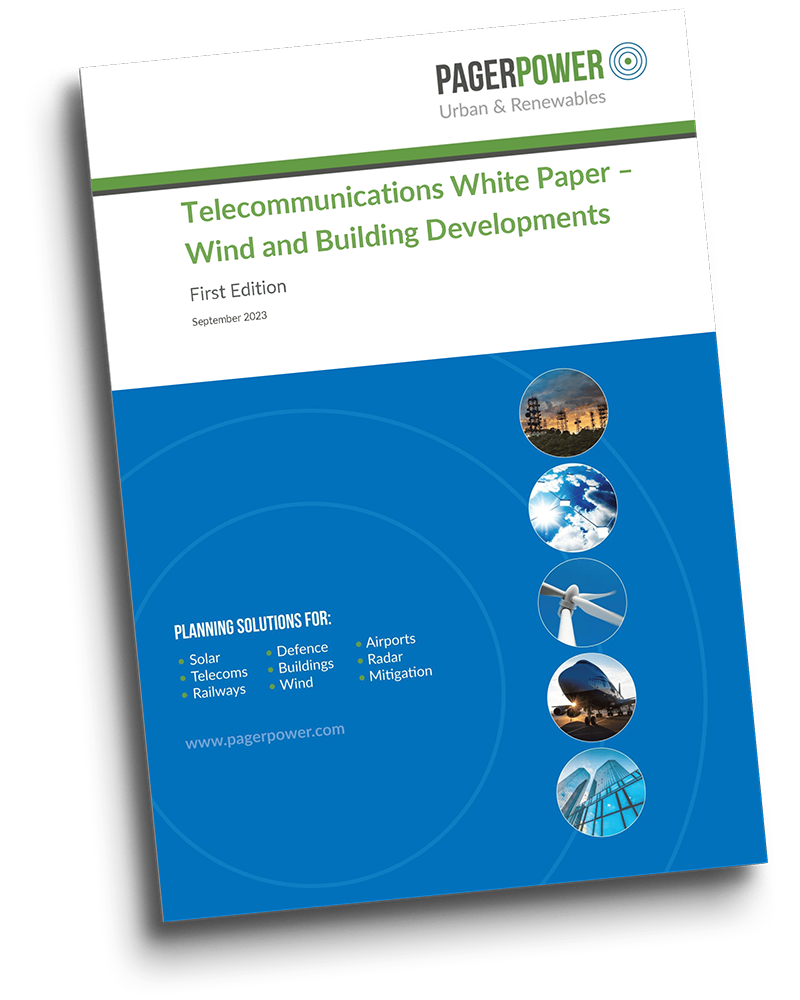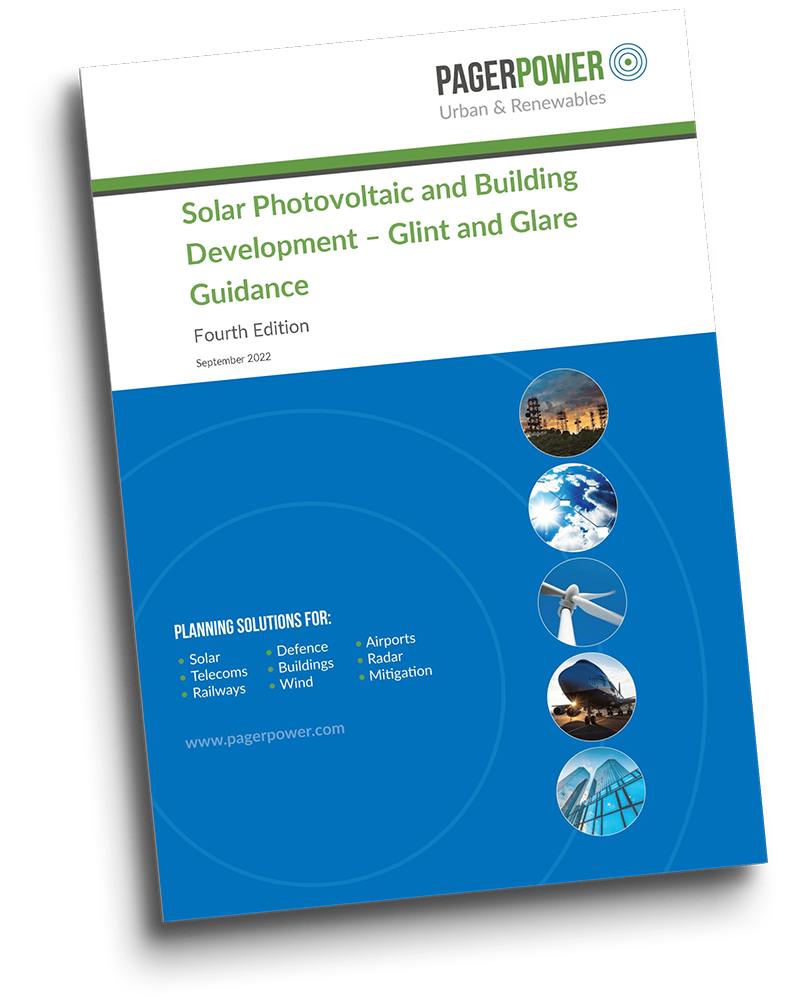Understanding the NSIP Process for Solar Developments

Nationally Significant Infrastructure Projects (NSIPs) are some of the largest and most complex developments in the England and Wales. For solar farms, any project above 50 MW in England (rising to 100 MW from December 2025) or 350 MW in Wales must follow the NSIP process, which culminates in securing a Development Consent Order (DCO).
Pager Power has supported multiple NSIP scale solar schemes, primarily through Glint and Glare assessments and, in some cases, Electromagnetic Field (EMF) assessments. This article explores the NSIP process in detail, the challenges developers face, and the role Pager Power plays in helping projects secure consent.
Figure 1: Solar farm, UK.
How NSIPs Differ from Standard Planning Applications
A critical difference between NSIPs and standard planning applications is who makes the decision.
- Standard planning applications – decided by the Local Planning Authority (LPA).
- NSIPs – examined by the Planning Inspectorate (PINS), with the final decision made by the Secretary of State for Energy Security and Net Zero.
This change has several implications for developers:
- National-level scrutiny – impacts must be tested against National Policy Statements, not just local planning policies.
- Formalised examination process – hearings, written submissions, and strict deadlines replace local committee debates.
- Stakeholder engagement at scale – statutory consultees, government departments, and national bodies carry more weight than local opposition.
- Greater expectation of robustness – technical assessments must be able to withstand cross-examination and public scrutiny.
For solar NSIPs, this means Glint and Glare (and sometimes EMF) assessments are not just planning formality, but a critical element in securing consent.
The NSIP Framework
The NSIP framework was established under the Planning Act 2008 to provide a clear, structured system for approving nationally significant energy, transport, water, waste, and other infrastructure projects.
Thresholds for Renewable Energy NSIPs
- Solar Farms – NSIP if over 50 MW in England (increasing to 100 MW in Dec 2025) or 350 MW in Wales
- Onshore Wind Farms – NSIP if over 50 MW in England
- Offshore Wind Farms – NSIP if over 100 MW
Development Consent Order (DCO)
The DCO is the central approval mechanism for NSIPs. It consolidates multiple permissions into a single order, covering:
- Planning permission
- Land acquisition powers
- Environmental permits
- Rights to alter highways, footpaths, or utilities
Because it combines many consents, the DCO process is rigorous and highly scrutinised.
Key Principles of the NSIP Process
- Public Participation – Multiple opportunities for stakeholders to comment
- Environmental Safeguards – Robust assessments of impacts and mitigations
- Policy Alignment – Consistency with National Policy Statements
- Transparency and Accountability – Evidence-based, open to challenge
Advantages and Challenges of the NSIP Process
Advantages:
- Clear and structured pathway for large-scale projects
- Balances national priorities with local/environmental concerns
- Streamlines decision-making through a single DCO
Challenges:
- Complex, resource intensive, and time-consuming
- Exposed to legal challenges that can delay implementation
- Requires extensive stakeholder engagement and consultation
The Six Stages of the NSIP Process
- Pre-Application
- Statement of Community Consultation (SoCC) and EIA.
- Scoping Reports define receptors.
- Pager Power contributes scoping assessments, PEIR input, and EIA reporting alongside technical reports as part of the EIA process.
- Acceptance
- PINS has 28 days to decide if the application can be examined.
- Our reports form part of the Environmental Statement, reducing risk of rejection.
- Pre-Examination
- Stakeholders register and submit Relevant Representations.
- Pager Power helps developers respond early to technical queries.
- Examination (6 months)
- Written submissions and hearings (Issue-Specific, Compulsory Acquisition, Open Floor).
- Pager Power provides written responses, attends hearings, and ensures our assessments withstand scrutiny.
- Recommendation & Decision
- The Examining Authority (ExA), a single Inspector or panel of Inspectors appointed by PINS, submits its findings and recommendations to the Secretary of State.
- The Secretary of State then has three months to approve or refuse the DCO application.
- Strong evidence from Pager Power helps avoid consent risks.
- Post-Decision
- If approved, the developer can implement the DCO.
- Judicial review is possible within six weeks.
Why NSIPs Face Greater Scrutiny
NSIPs can require:
- Modelling of additional receptors such as AONBs, public footpaths, or bridleways.
- Detailed screening analysis and surveys to inform visibility.
- Cross-discipline collaboration (e.g. with LVIA)
- Multiple rounds of client and legal reviews
Where screening isn’t feasible, we can recommend and implement layout optimisation to reduce impacts early.
EMF Assessments for NSIPs
While Glint and Glare is often a more visible planning issue, Electromagnetic Field (EMF) impacts are also relevant for many solar NSIPs due to the associated substations and cabling.
Pager Power has delivered EMF assessments for multiple NSIPs, addressing:
- Compliance with EMF exposure guidelines
- Potential health concerns raised by local communities
- Integration of findings into Environmental Statements and Examination submissions
These assessments provide reassurance for consultees in accordance with the associated guidelines and help developers demonstrate that projects are safe, compliant, and well managed.
Stakeholder Engagement
- PINS expects early and proactive consultation.
- National consultees (e.g. MoD, NATS, licensed airports) carry more weight than local opposition, though all concerns must be addressed.
- Missed consultation can lead to concessions — in one case site capacity was lost.
Pager Power provides the technical evidence base to address consultee concerns with confidence.
Examination in Practice – Consistent Themes
- Need for cross-discipline coordination
- Forward planning of resources
- Tight and persistent deadlines
- Strong link between hearings and written submissions
- Not just answering questions, but making the case
- Resolving issues early wherever possible
Practical Realities of NSIPs
- DCO documents can go through multiple iterations
- Examinations vary depending on Inspectors’ style
- Stakeholder management is ongoing and complex
- Constructive relationship with PINS case officers is crucial
- Applicants must make quick, informed decisions when issues arise
Pager Power’s NSIP Experience
Pager Power has delivered Glint and Glare and EMF assessments for 18 solar NSIPs as of September 2025, including:
- Botley West Solar Farm
- Byers Gill Solar
- Cleve Hill Solar Park
- Cottam Solar Project
- Helios Renewable Energy Project
- Light Valley Solar
- Lime Down Solar Project
- Little Crow Solar Park
- Longfield Solar Farm
- Mallard Pass Solar Project
- Oaklands Farm Solar Project
- Peartree Hill Solar Farm
- Penderi Solar Development
- Stonestreet Green Solar
- Sunnica Energy Farm
- The Droves Solar Farm
- Tween Bridge Solar Farm
- West Burton Solar Project
Explore these and other projects on the Planning Inspectorate’s NSIP register.
Conclusion
The NSIP process is rigorous and highly scrutinised, but with the right technical expertise, projects can succeed. Pager Power’s proven track record in Glint and Glare and EMF assessments ensures that developers have the robust, defensible evidence needed to secure consent.
Enquire now to discuss your NSIP solar project.
Figure 1: Getty Image from Unsplash.com+. Last accessed on 25th September 2025. Available at: https://unsplash.com/photos/aerial-view-of-solar-panels-on-green-field-at-suburb-in-sunny-day-9t5RoSvmabAhttps://www.pagerpower.com/wp-content/uploads/2025/09/NSIPs-thumbnail.jpeg







